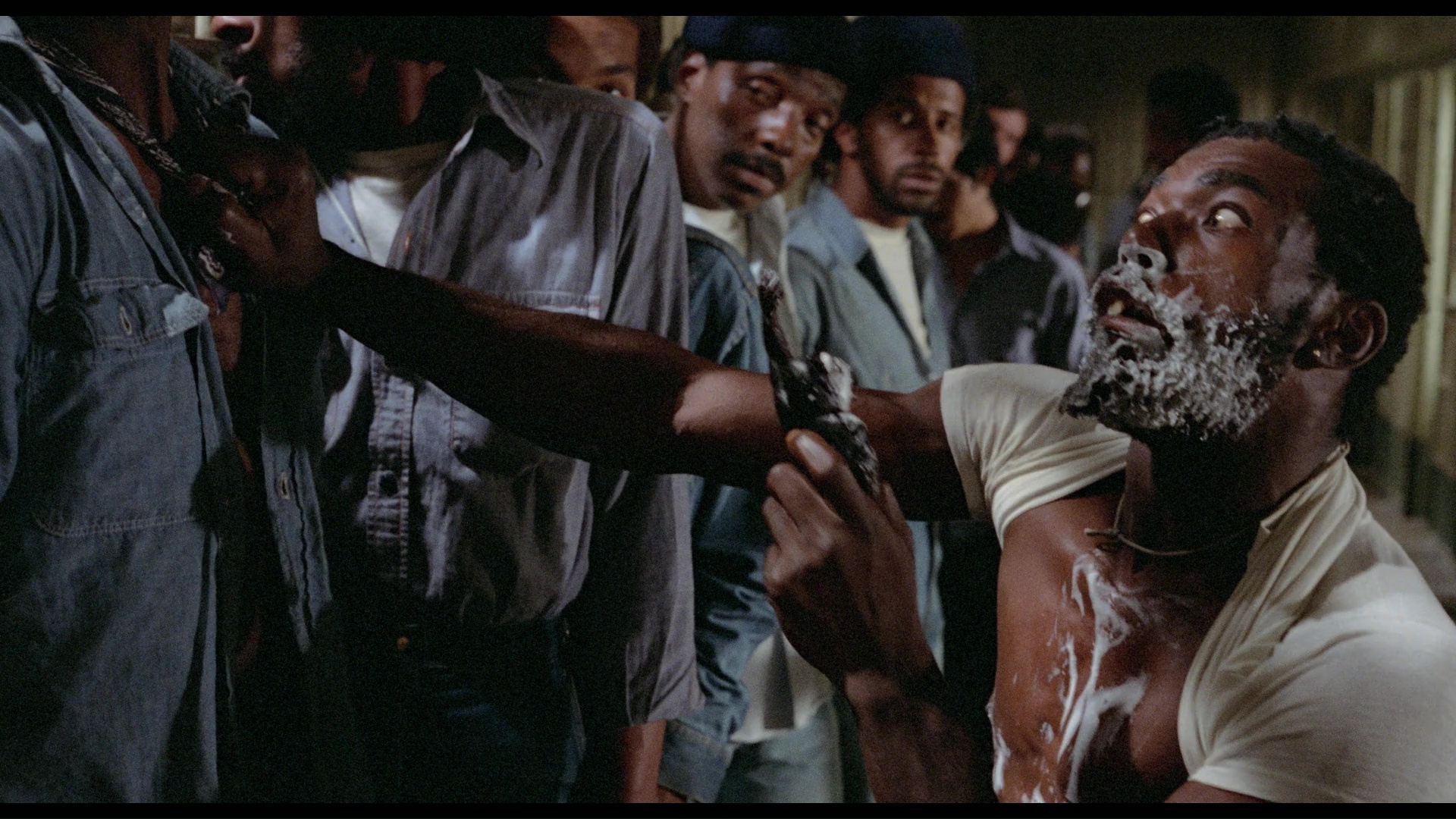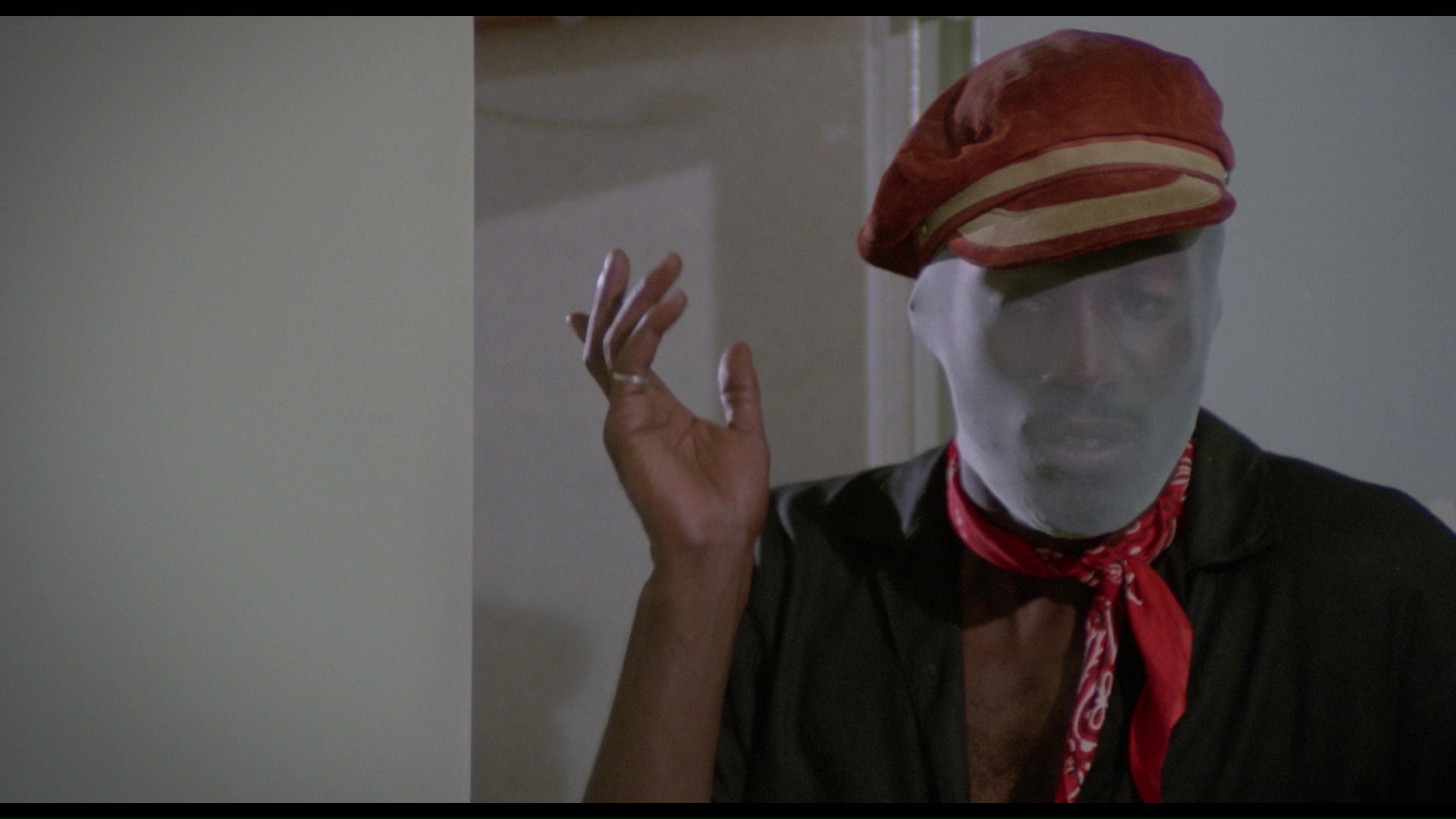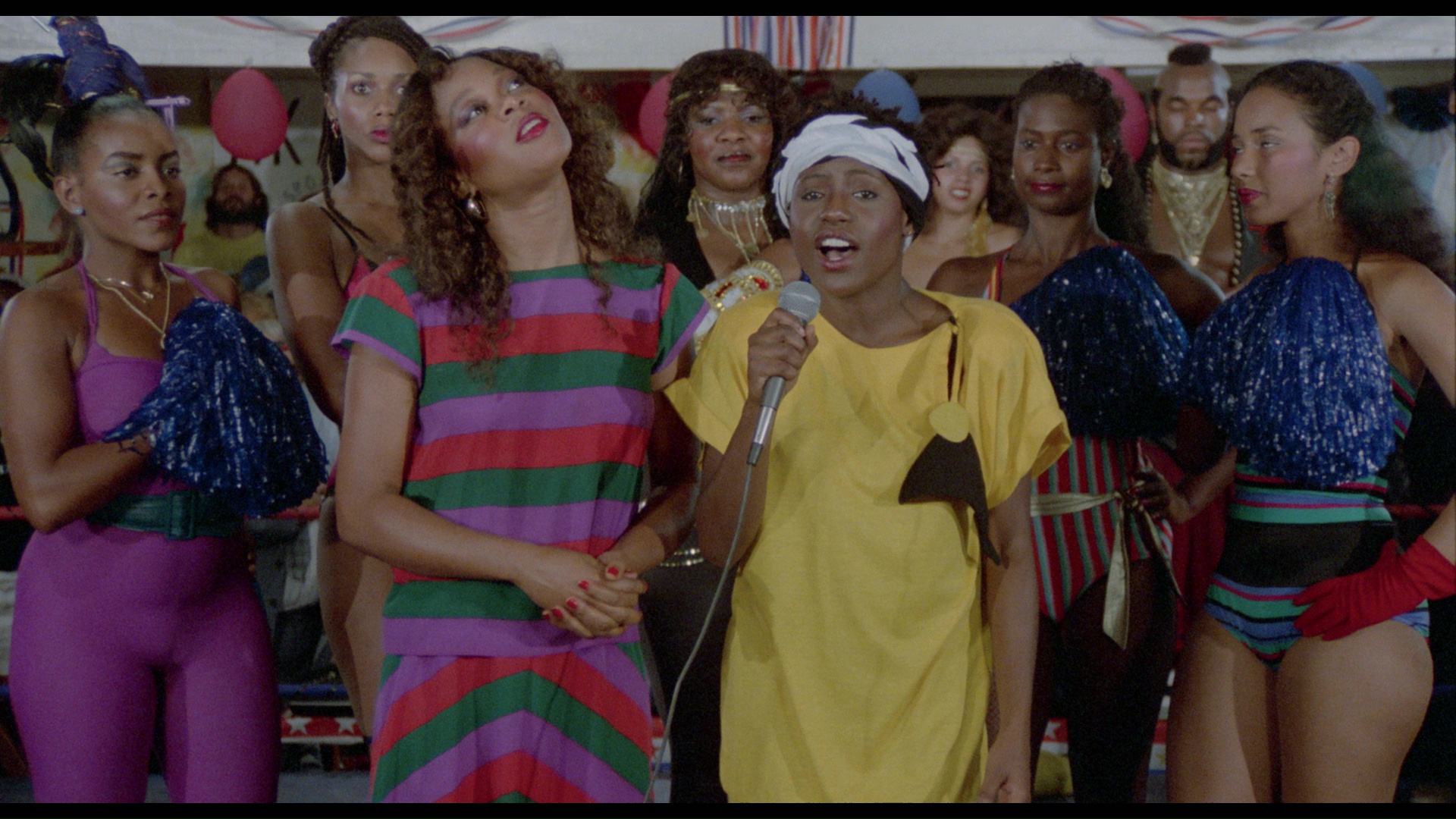


PENITENTIARY
Color, 1979, 99 mins. 7 secs.
Directed by Jamaa Fanaka
Starring Leon Isaac Kennedy, Wilbur 'Hi-Fi' White, Thomas M. Pollard, Hazel Spears, Donovan Womack, Floyd Chatman, Badja Djola, Chuck Mitchell
PENITENTIARY II
Color,
1982, 108 mins. 46 secs.
Directed by Jamaa Fanaka
Starring Leon Isaac Kennedy, Glynn Turman, Ernie Hudson, Mr. T, Peggy Blow, Sephton Moody, Donovan Womack, Malik Carter
Vinegar Syndrome (Blu-ray & DVD) (US R0 HD/NTSC) / WS (1.85:1) (16:9), Xenon (DVD) (US R1 NTSC), Arrow (DVD) (UK R2 PAL)
 big success story from
big success story from  the tail end of the golden age of '70s American black cinema was a scrappy indie film called Penitentiary, the brainchild of an Air Force vet and UCLA grad named Jamaa Fanaka. Already a notable talent thanks to the outrageous Welcome Home Brother Charles and gritty Emma Mae, Fanaka proclaimed his intention to buck the parade of pushers, pimps and prostitutes that had become the primary mode of representation from major studios, so he came up with this underdog story that he wrote and directed as an intended thesis project. Released by the legendary Jerry Gross Organization (just before it unleashed Zombie on the U.S.), the film became a surprise hit and spawned two sequels, both handled by Fanaka as well.
the tail end of the golden age of '70s American black cinema was a scrappy indie film called Penitentiary, the brainchild of an Air Force vet and UCLA grad named Jamaa Fanaka. Already a notable talent thanks to the outrageous Welcome Home Brother Charles and gritty Emma Mae, Fanaka proclaimed his intention to buck the parade of pushers, pimps and prostitutes that had become the primary mode of representation from major studios, so he came up with this underdog story that he wrote and directed as an intended thesis project. Released by the legendary Jerry Gross Organization (just before it unleashed Zombie on the U.S.), the film became a surprise hit and spawned two sequels, both handled by Fanaka as well.  obstacles await as Too Sweet has to punch his way to freedom -- even if it means facing off against imposing gang leader Jesse "The Bull" Amos.
obstacles await as Too Sweet has to punch his way to freedom -- even if it means facing off against imposing gang leader Jesse "The Bull" Amos.
 Half Dead wants payback and gets personal in a very murderous way, which forces Too Sweet to put his boxing gloves on once again.
Half Dead wants payback and gets personal in a very murderous way, which forces Too Sweet to put his boxing gloves on once again.  The second film goes for pure outrageous insanity, including a banana pudding sex scenes (with Hudson in a red Speedo no less), Bad Santa's Tony Cox as a midget bookie, and a surprisingly vicious murder scene involving toilet drowning, among other surprises. It really says something when Mr. T isn't the flashiest thing in the film. On the other hand, the first film plays it more or less straight, its moments of violence emerging naturally from the characters to offer the necessary crowd-pleasing moments of slugging and bloodshed. The fact that a lot had changed in the three years between the films is obvious, too, with the hazy, sweaty atmosphere of the first giving way to colorful, over the top '80s attitude in the second including some fashion choices you'll never believe, a disco-dancing mime, and a final shot straight out of a sitcom. There's even a cameo by Rudy Ray Moore,
The second film goes for pure outrageous insanity, including a banana pudding sex scenes (with Hudson in a red Speedo no less), Bad Santa's Tony Cox as a midget bookie, and a surprisingly vicious murder scene involving toilet drowning, among other surprises. It really says something when Mr. T isn't the flashiest thing in the film. On the other hand, the first film plays it more or less straight, its moments of violence emerging naturally from the characters to offer the necessary crowd-pleasing moments of slugging and bloodshed. The fact that a lot had changed in the three years between the films is obvious, too, with the hazy, sweaty atmosphere of the first giving way to colorful, over the top '80s attitude in the second including some fashion choices you'll never believe, a disco-dancing mime, and a final shot straight out of a sitcom. There's even a cameo by Rudy Ray Moore,  in case you were on the fence about watching this one.
in case you were on the fence about watching this one.  2018, Vinegar Syndrome issued the first and second films in Blu-ray / DVD dual-format sets, both transferred from the original negatives and looking far, far better than they ever have before. The fuzzy detail and milky blacks from the old DVDs are long gone now, replaced with a fresh, crystal clear appearance that gives the films far more immediacy and polish. It's especially jarring (in a good way) to see the first film in such good shape since it's been hampered by its outdated, '80s-era master for so long. The DTS-HD MA English tracks for both sound excellent as well (with optional English SDH subtitles provided).
2018, Vinegar Syndrome issued the first and second films in Blu-ray / DVD dual-format sets, both transferred from the original negatives and looking far, far better than they ever have before. The fuzzy detail and milky blacks from the old DVDs are long gone now, replaced with a fresh, crystal clear appearance that gives the films far more immediacy and polish. It's especially jarring (in a good way) to see the first film in such good shape since it's been hampered by its outdated, '80s-era master for so long. The DTS-HD MA English tracks for both sound excellent as well (with optional English SDH subtitles provided).  a nap if you aren't careful. And yes, he openly admits the opening crawl in Penitentiary II is an outright salute to Star Wars of all things. The first film also comes with a commentary featuring second assistant director Sergio Mims, who's very lively and rattles off facts like crazy for the entire running time; you might want to start with that one first. Penitentiary II also features an isolated score track (lossy Dolby Digital, but better than nothing), a really nice addition.
a nap if you aren't careful. And yes, he openly admits the opening crawl in Penitentiary II is an outright salute to Star Wars of all things. The first film also comes with a commentary featuring second assistant director Sergio Mims, who's very lively and rattles off facts like crazy for the entire running time; you might want to start with that one first. Penitentiary II also features an isolated score track (lossy Dolby Digital, but better than nothing), a really nice addition. 
 marketing), the original plans to replace him with a different actor, and the Rocky III factor.
marketing), the original plans to replace him with a different actor, and the Rocky III factor. as a director and cinematographer evolved out of film school along with other artistic pursuits, with this film posing a particular challenge in its creation of a prison atmosphere on limited sets. In “Producing Penitentiary” (28m14s), co-producer Alicia Dhanifu recalls being in film school with Fanaka intending to be a TV producer and wound up in the middle of what amounted to a student film with major ambitions. Her chronology with this film and Rocky is off by quite a bit, but otherwise there's a lot of good info here. The second film also boasts an archival, mostly unedited Fanaka interview, "In the Raw" (27m39s), in which he goes into his personal artistic process, the tricks of film distribution, the joys of watching your film on 42nd Street, and his hopes for the future of filmmaking. Theatrical trailers are also included for their respective films, and the reversible art options include your choice of theatrical poster art.
as a director and cinematographer evolved out of film school along with other artistic pursuits, with this film posing a particular challenge in its creation of a prison atmosphere on limited sets. In “Producing Penitentiary” (28m14s), co-producer Alicia Dhanifu recalls being in film school with Fanaka intending to be a TV producer and wound up in the middle of what amounted to a student film with major ambitions. Her chronology with this film and Rocky is off by quite a bit, but otherwise there's a lot of good info here. The second film also boasts an archival, mostly unedited Fanaka interview, "In the Raw" (27m39s), in which he goes into his personal artistic process, the tricks of film distribution, the joys of watching your film on 42nd Street, and his hopes for the future of filmmaking. Theatrical trailers are also included for their respective films, and the reversible art options include your choice of theatrical poster art. 



